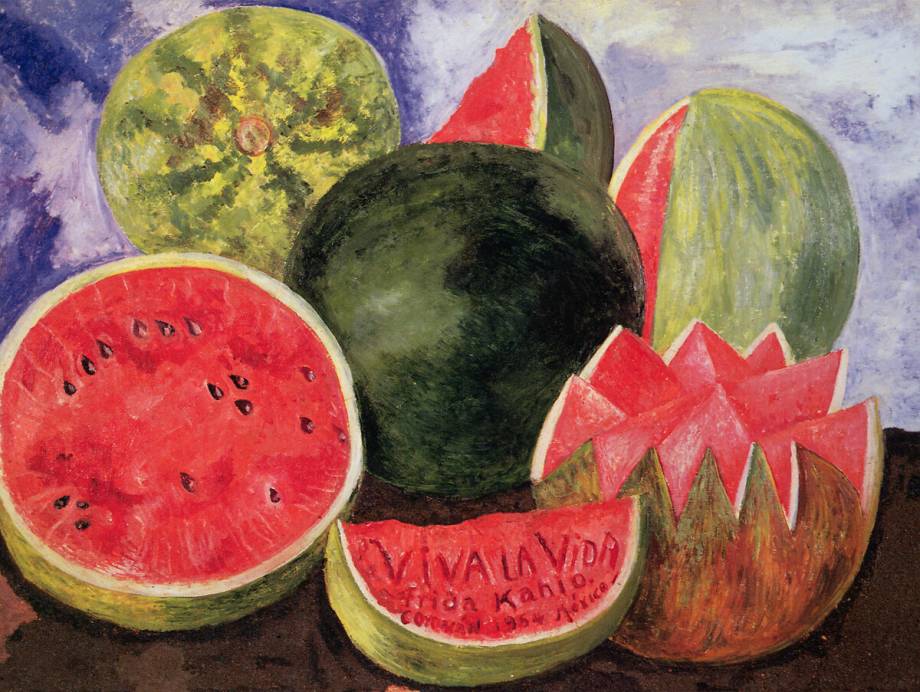Shop art print and framed art Viva la Vida by Frida Kahlo
Customise
Your art print
Viva la Vida OF Frida Kahlo
-20%Viva la Vida
The background to the creation of "Viva la vida"
Frida Kahlo, the famous Mexican painter, created this painting in 1954, shortly before her death. She was 47 at the time and suffering from numerous health complications. Despite the pain and difficulties she faced, she chose to create a work full of strength and gaiety.
A message of love for life despite the trials
"Viva la vida" can be seen as a hymn to life, a way for Frida Kahlo to show that even in the darkest of times, beauty and joy can be found. The watermelons depicted in the painting are a powerful symbol: they embody the generosity of nature and the simple pleasures of everyday life. What's more, this pink-fleshed fruit is also an emblematic food of Mexico, her country of origin, to which the artist remains very attached throughout her life.
A fascinating artistic composition
The painting "Viva la vida" is built around a series of watermelons painted in close-up and arranged to form a rainbow of colours. Each fruit is depicted in great detail, demonstrating Frida Kahlo's talent for drawing and colour.
An original still life
In this work, watermelons take centre stage thanks to their imposing size and bright colours. They take up almost the entire surface of the painting, leaving little room for the background, which depicts a cloudy sky treated in an almost abstract way. This staging gives the fruit a particular importance: they become the focus of our attention through their monumental dimensions.
The use of colour and contrast
Frida Kahlo shows great mastery in her use of colour in "Viva la vida". Dark and pale greens are skilfully combined in contrasts to render the mottled effects of the fruit skins. The watermelons, with their warm, vibrant hues, have also been cut in a variety of ways, so as to offer the eye all the points of view from which it can view the fruit. This choice, as well as accentuating the effect of abundance, attests to a great sense of composition.
The symbolism of watermelons in art
Watermelons have been used several times in the history of art, particularly by certain painters of the realist movement. These artists were fascinated by fruit and vegetables, which they considered worthy subjects for study. In this respect, "Viva la Vida" is not unlike the Spanish "bodegones" of the 17th and 18th centuries: still lifes depicting tables laid with lemons, oranges, watermelons and other colourful foods. Preserved in the Prado Museum, La Nature Morte aux pastèques by Luis Egidio Melendez is just one example.
Watermelons as a symbol of fertility and prosperity
In some cultures, watermelons are associated with fertility because of their round shape and numerous seeds. They also symbolise prosperity and abundance thanks to their imposing size and juicy flesh packed with vitamins and nutrients.
A fruit emblematic of Mexico
In Frida Kahlo's native Mexico, watermelons are a true cultural symbol. Eaten at festivals and celebrations, they are often given as gifts to wish loved ones good luck and success. By choosing to paint watermelons in "Viva la vida", Frida Kahlo refers to this Mexican tradition and expresses her attachment to her native country. The painter and fresco artist Diego Rivera, no doubt influenced by Frida Khalo and the ubiquity of this fruit on Mexican stalls, also regularly incorporated them into his settings.
This artwork is a painting from the modern period. It belongs to the realism styles and surrealism styles.
« Viva la Vida » is kept at Private Collection.



































